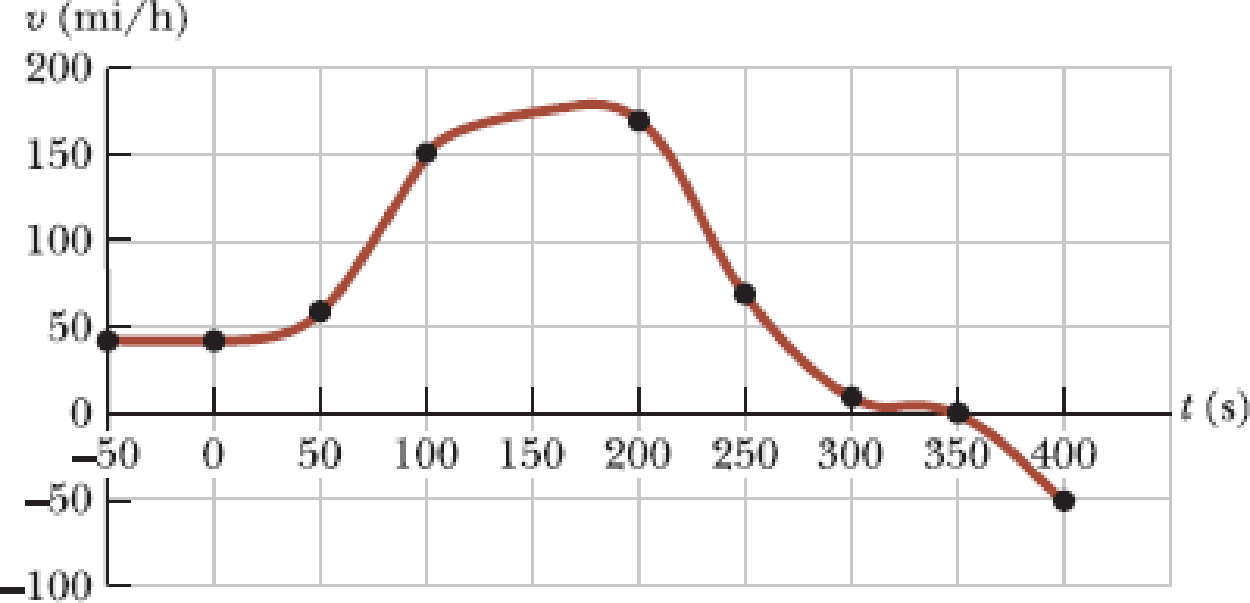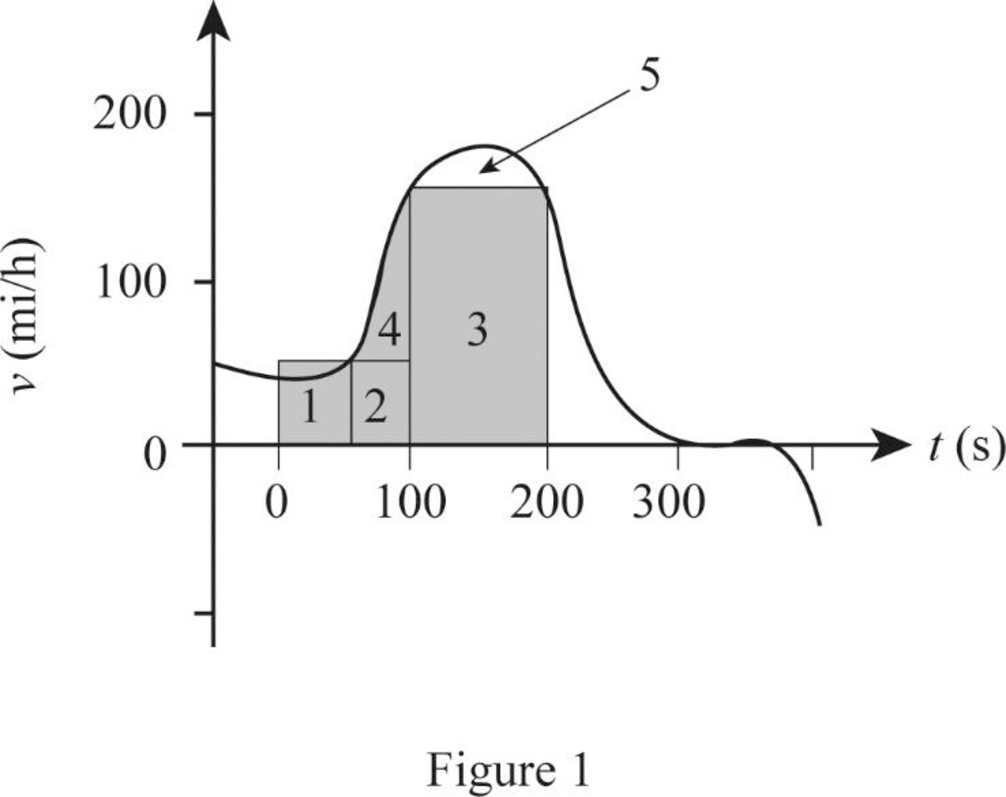
Concept explainers
The Acela is an electric train on the Washington–New York–Boston run, carrying passengers at 170 mi/h. A velocity–time graph for the Acela is shown in Figure P2.46. (a) Describe the train’s motion in each successive time interval. (b) Find the train’s peak positive acceleration in the motion graphed. (c) Find the train’s displacement in miles between t = 0 and t = 200 s.
Figure P2.46 Velocity versus time graph for the Acela.

(a)
The description of the train’s motion in each successive time interval.
Answer to Problem 46P
Initially A is moving at constant positive velocity in the
Explanation of Solution
In the given velocity versus time graph of A, the curve is parallel to the time axis in the interval
From around
Conclusion:
Thus, initially A is moving at constant positive velocity in the
(b)
The train’s peak positive acceleration in the motion graphed.
Answer to Problem 46P
The train’s peak positive acceleration in the motion graphed is
Explanation of Solution
The slope of the graph in a given interval gives the acceleration of the object during it. The region of steepest slope in the
Write the equation for the acceleration of the object.
Here,
Write the equation for the slope.
Here,
Put the above equation in equation (I).
Conclusion:
Substitute
Therefore, the train’s peak positive acceleration in the motion graphed is
(c)
The train’s displacement in miles between
Answer to Problem 46P
The train’s displacement in miles between
Explanation of Solution
The cumulative area under the velocity versus time graph between
The velocity versus time graph is shown below.

Write the equation for the area of a rectangle.
Here,
Write the equation for the area of a triangle.
Here,
The area from
In figure 1, the length of the rectangle from
Substitute
Here,
The area from
In figure 1, the length of the rectangle from
Substitute
Here,
In figure 1, the base of the triangle from
Substitute
Here,
The area from
In figure 1, the length of the rectangle from
Substitute
Here,
In figure 1, the base of the triangle from
Substitute
Here,
Write the equation for the net displacement.
Here,
Conclusion:
Substitute
Therefore, the train’s displacement in miles between
Want to see more full solutions like this?
Chapter 2 Solutions
Principles of Physics: A Calculus-Based Text, Hybrid (with Enhanced WebAssign Printed Access Card)
- Which of the following best describes how to calculate the average acceleration of any object? Average acceleration is always halfway between the initial acceleration of an object and its final acceleration. Average acceleration is always equal to the change in velocity of an object divided by the time interval. Average acceleration is always equal to the displacement of an object divided by the time interval. Average acceleration is always equal to the change in speed of an object divided by the time interval.arrow_forwardThe figure shows the velocity versus time graph for a car driving on a straight road. Which of the following best describes the acceleration of the car? v (m/s) t(s) The acceleration of the car is negative and decreasing. The acceleration of the car is constant. The acceleration of the car is positive and increasing. The acceleration of the car is positive and decreasing. The acceleration of the car is negative and increasing.arrow_forwardWhich figure could represent the velocity versus time graph of a motorcycle whose speed is increasing? v (m/s) v (m/s) t(s) t(s)arrow_forward
- Unlike speed, velocity is a the statement? Poisition. Direction. Vector. Scalar. quantity. Which one of the following completesarrow_forwardNo chatgpt pls will upvote Already got wrong chatgpt answerarrow_forward3.63 • Leaping the River II. A physics professor did daredevil stunts in his spare time. His last stunt was an attempt to jump across a river on a motorcycle (Fig. P3.63). The takeoff ramp was inclined at 53.0°, the river was 40.0 m wide, and the far bank was 15.0 m lower than the top of the ramp. The river itself was 100 m below the ramp. Ignore air resistance. (a) What should his speed have been at the top of the ramp to have just made it to the edge of the far bank? (b) If his speed was only half the value found in part (a), where did he land? Figure P3.63 53.0° 100 m 40.0 m→ 15.0 marrow_forward
 Principles of Physics: A Calculus-Based TextPhysicsISBN:9781133104261Author:Raymond A. Serway, John W. JewettPublisher:Cengage Learning
Principles of Physics: A Calculus-Based TextPhysicsISBN:9781133104261Author:Raymond A. Serway, John W. JewettPublisher:Cengage Learning Physics for Scientists and Engineers: Foundations...PhysicsISBN:9781133939146Author:Katz, Debora M.Publisher:Cengage Learning
Physics for Scientists and Engineers: Foundations...PhysicsISBN:9781133939146Author:Katz, Debora M.Publisher:Cengage Learning University Physics Volume 1PhysicsISBN:9781938168277Author:William Moebs, Samuel J. Ling, Jeff SannyPublisher:OpenStax - Rice University
University Physics Volume 1PhysicsISBN:9781938168277Author:William Moebs, Samuel J. Ling, Jeff SannyPublisher:OpenStax - Rice University Glencoe Physics: Principles and Problems, Student...PhysicsISBN:9780078807213Author:Paul W. ZitzewitzPublisher:Glencoe/McGraw-Hill
Glencoe Physics: Principles and Problems, Student...PhysicsISBN:9780078807213Author:Paul W. ZitzewitzPublisher:Glencoe/McGraw-Hill Physics for Scientists and Engineers with Modern ...PhysicsISBN:9781337553292Author:Raymond A. Serway, John W. JewettPublisher:Cengage Learning
Physics for Scientists and Engineers with Modern ...PhysicsISBN:9781337553292Author:Raymond A. Serway, John W. JewettPublisher:Cengage Learning Physics for Scientists and Engineers, Technology ...PhysicsISBN:9781305116399Author:Raymond A. Serway, John W. JewettPublisher:Cengage Learning
Physics for Scientists and Engineers, Technology ...PhysicsISBN:9781305116399Author:Raymond A. Serway, John W. JewettPublisher:Cengage Learning





